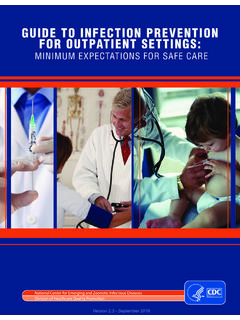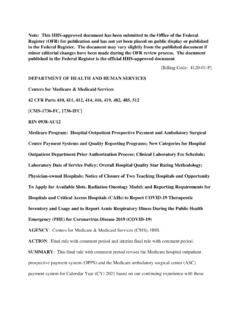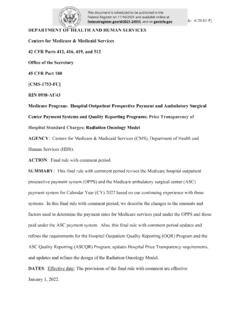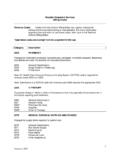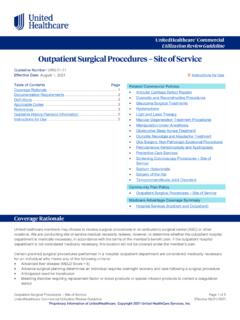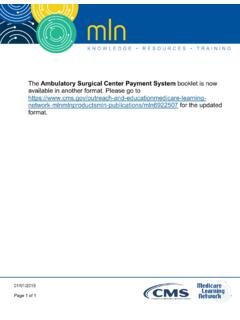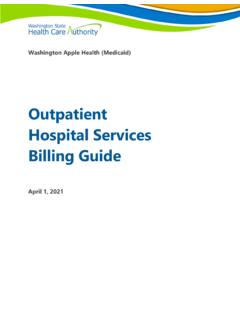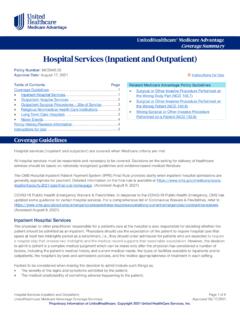Transcription of National Health Statistics Reports
1 DEPARTMENT OF Health AND HUMAN SERVICESC enters for Disease Control and PreventionNational Center for Health StatisticsAmbulatory Surgery Data From Hospitals and ambulatory Surgery Centers: United States, 2010by Margaret J. Hall, , Alexander Schwartzman, Jin Zhang, and Xiang Liu, Division of Health Care StatisticsAbstractObjectives This report presents National estimates of surgical and nonsurgical ambulatory procedures performed in hospitals and ambulatory surgery centers (ASCs) in the United States during 2010. Patient characteristics, including age, sex, expected payment source, duration of surgery, and discharge disposition are presented, as well as the number and types of procedures performed in these settings.
2 Methods Estimates in this report are based on ambulatory surgery data collected in the 2010 National hospital ambulatory Medical Care Survey (NHAMCS). NHAMCS has collected outpatient department and emergency department data since 1992 and began gathering ambulatory surgery data from both hospitals and ASCs in 2010. Sample data were weighted to produce annual National In 2010, million surgical and nonsurgical procedures were performed during million ambulatory surgery visits to hospitals and ASCs combined. For both males and females, 39% of procedures were performed on those aged 45 64.
3 For females, about 24% of procedures were performed on those aged 15 44 compared with 18% for males, whereas the percentage of procedures performed on those under 15 was lower for females than for males (4% compared with 9%). About 19% of procedures were performed on those aged 65 74, while about 14% were performed on those aged 75 and over. Private insurance was listed as the principal expected source of payment for 51% of ambulatory surgery visits, Medicare for 31% of visits, and Medicaid for 8% of visits. The most frequently performed procedures included endoscopy of large intestine ( million), endoscopy of small intestine ( million), extraction of lens ( million), insertion of prosthetic lens ( million), and injection of agent into spinal canal ( million).
4 Only 2% of visits with a discharge status were admitted to the hospital as an : outpatient surgery procedures ICD 9 CM National hospital ambulatory Medical Care Survey (NHAMCS)IntroductionThis report presents nationally representative estimates of ambulatory surgery performed in hospitals and ambulatory surgery centers (ASCs) gathered by the 2010 National hospital ambulatory Medical Care Survey (NHAMCS). ambulatory surgery, also called outpatient surgery, refers to surgical and nonsurgical procedures that are nonemergency, scheduled in advance, and generally do not result in an overnight hospital stay.
5 ambulatory surgery has increased in the United States since the early 1980s (1,2). Two factors that contributed to this increase were medical and technological advancements, including improvements in anesthesia and in analgesics for the relief of pain, and the development and expansion of minimally invasive and noninvasive procedures (such as laser surgery, laparoscopy, and endoscopy) (3 6). Before these advances, almost all surgery was performed in inpatient settings. Any outpatient surgery was likely to have been minor, performed in physicians offices, and paid for by Medicare and insurers as part of the physician s office visit reimbursement.
6 National Health Statistics ReportsNumber 102 February 28, 2017 Page 2 National Health Statistics Reports Number 102 February 28, 2017 The above advances and concerns about rising Health care costs led to changes in the Medicare program in the early 1980s that encouraged growth in ambulatory surgery. Medicare expanded coverage to include surgery performed in ASCs (both hospital -based and freestanding). In addition, a prospective payment system for hospitals based on diagnosis-related groups was adopted, and that created strong financial incentives for hospitals to shift some surgery out of the hospital (1 5).
7 ambulatory surgery proved to be popular among both physicians and patients (3,4,7,8), and the number of Medicare-certified ASCs increased steadily, from 239 in 1983 to 5,316 in 2010 (9,10). This report covers ambulatory surgery performed in hospitals and ASCs that are independent of hospitals. ambulatory surgery procedures performed in physicians offices and independent screening or diagnostic centers were not included in this source and sampling designData for this analysis are from the ambulatory surgery component of the 2010 NHAMCS, a nationally representative survey of hospitals and ASCs conducted by the National Center for Health Statistics (NCHS).
8 This survey has provided data on ambulatory medical care services provided in hospital emergency and outpatient departments since 1992. From 2010 through 2012, NHAMCS gathered data on ambulatory surgery procedures in both hospitals and ASCs. In 2013, data collection in ASCs was suspended so a new sampling frame could be developed. Previously, during 1994 1996 and in 2006, the National Survey of ambulatory Surgery (NSAS) gathered data from hospital -based ASCs (HBASCs) and from facilities independent of hospitals [then called freestanding ASCs (FSASCs)] (2). The terms HBASC and FSASC are no longer in use because Medicare, and other insurers following Medicare s lead, changed the name and nature of the reimbursement categories for these services.
9 ambulatory surgery performed in hospitals is now called hospital outpatient department surgery. Facilities independent of hospitals that specialize in ambulatory surgery are now known as ASCs. Independent samples of hospitals and ASCs were drawn for the NHAMCS ambulatory surgery component. The NHAMCS hospital sample (11) was selected using a multistage probability design, first sampling geographic units and then hospitals. Locations within the hospital where the services of interest were provided, in this case ambulatory surgery, were sampled next. Lastly, patient visits within these locations were sampled.
10 The hospitals that qualify for inclusion in this survey (the universe) include noninstitutional hospitals (excluding federal, military, and Department of Veterans Affairs hospitals) located in the 50 states and the District of Columbia. Only short-stay hospitals (hospitals with an average length of stay for all patients of fewer than 30 days), those with a general specialty (medical or surgical ), and children s general were included in the survey. These hospitals must also have six or more beds staffed for patient use. The 2010 NHAMCS hospital sample frame was constructed from the products of SDI Health s Healthcare Market Index, which was updated July 15, 2006, and its hospital Market Profiling Solution, Second Quarter, 2006 (12).










